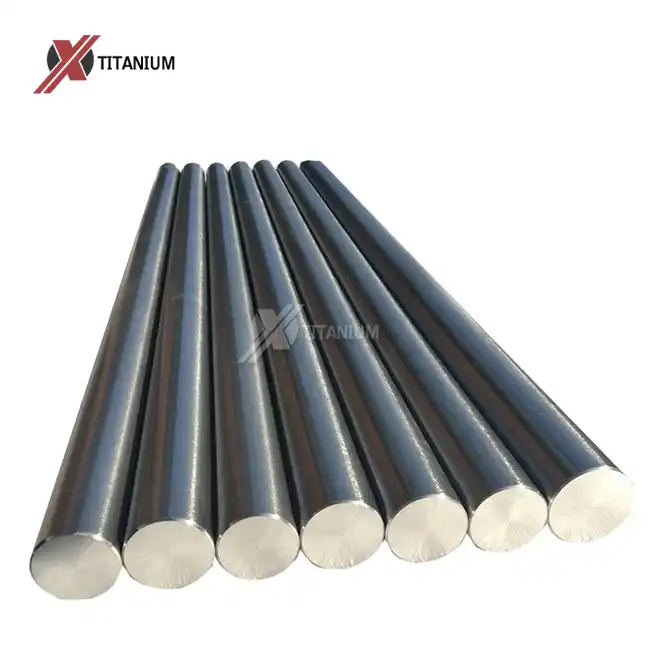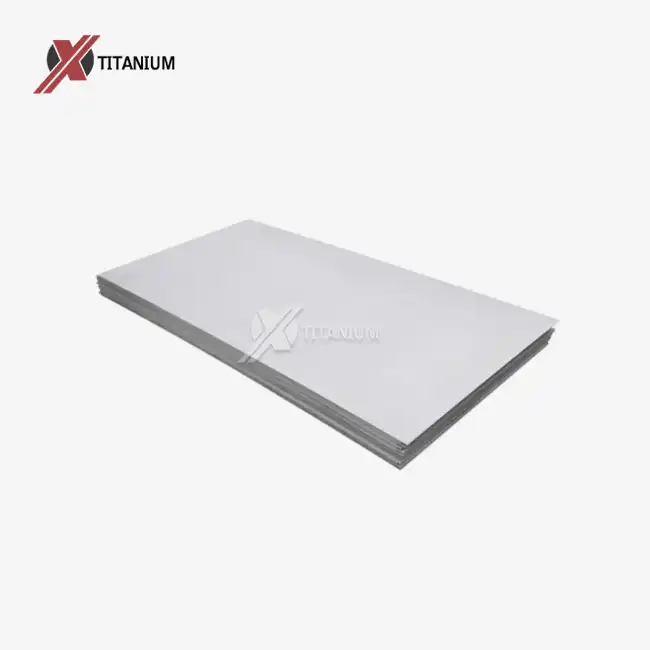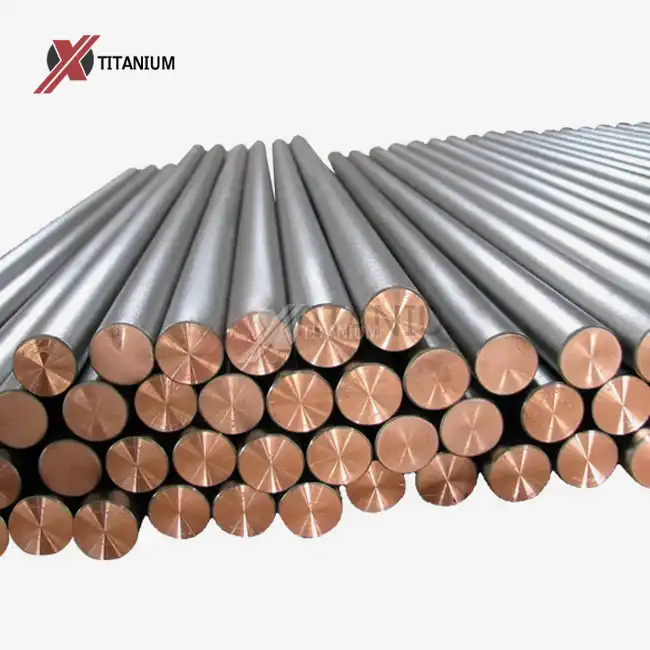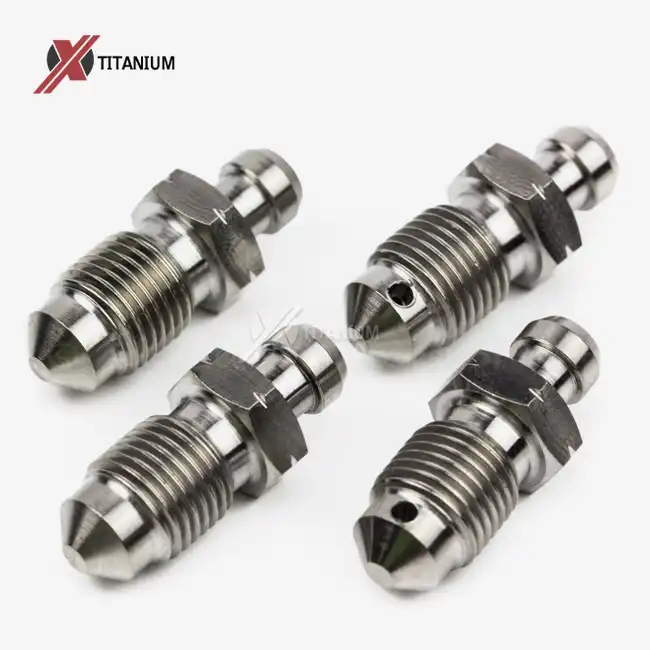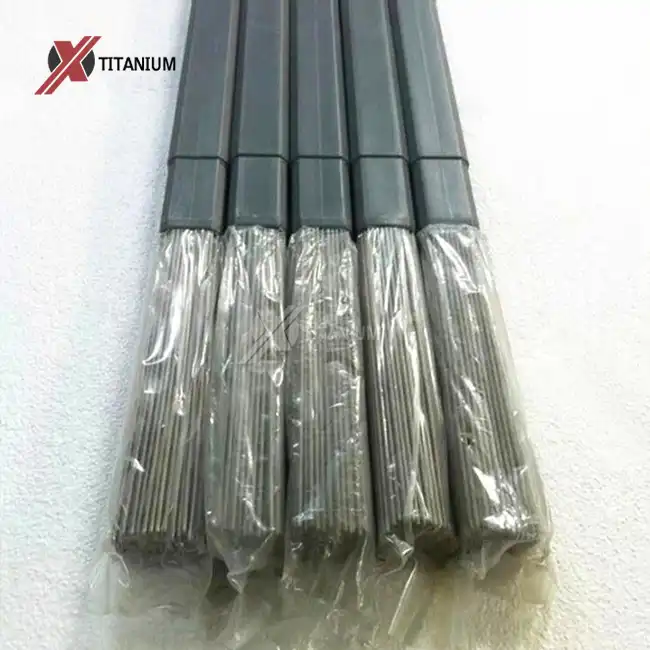The Impact of Forging on Titanium Alloy Rod Sustainability
Microstructural Advantages of Forged Titanium Alloy Rods
Forging titanium alloy rods imparts unique microstructural characteristics that significantly enhance their sustainability profile. The intense mechanical deformation during forging refines grain structures, leading to improved strength and durability. This refined microstructure results in titanium alloy rods with superior mechanical properties, including higher tensile strength and yield strength, often ranging from 900 to 1100 MPa and 700 to 950 MPa, respectively. The enhanced microstructure also contributes to increased hardness, typically between 35 to 40 HRC for forged titanium alloy rods.
The sustainability benefits of these microstructural improvements are manifold. Forged titanium alloy rods exhibit exceptional resistance to fatigue and stress, leading to prolonged service life in demanding applications. This longevity reduces the frequency of replacements, thereby conserving resources and minimizing waste generation over time. Moreover, the improved microstructure enhances the rod's resistance to environmental degradation, further extending its useful life and reducing the need for protective coatings or treatments that may have additional environmental impacts.
Energy Efficiency and Material Utilization in Forging Processes
While forging titanium alloy rods is energy-intensive, the process offers several sustainability advantages in terms of material utilization and long-term energy savings. The forging process allows for near-net-shape production, minimizing material waste compared to subtractive manufacturing methods. This efficient material usage is particularly crucial for titanium alloys, given their high embodied energy and the scarcity of titanium resources.
Forging also enables the production of titanium alloy rods with consistent properties throughout their cross-section, ranging from 5mm to 200mm in diameter. This uniformity ensures optimal performance across various applications, from aerospace components to medical implants, maximizing the utility of each rod produced. The energy invested in the forging process is often offset by the enhanced performance and extended lifespan of the final product, leading to net energy savings over the rod's lifecycle.
Recyclability and End-of-Life Considerations for Forged Titanium Alloy Rods
The sustainability of forged titanium alloy rods extends to their end-of-life phase, where recyclability plays a crucial role. Forged titanium alloys maintain their high value even after their primary use, making them attractive for recycling. The well-defined and consistent microstructure of forged rods facilitates easier recycling processes, as the material's properties are more predictable and uniform.
Recycling forged titanium alloy rods conserves significant energy compared to primary production, with energy savings of up to 95% reported in some cases. This high recyclability contributes to a circular economy model, where materials are kept in use for as long as possible, reducing the demand for virgin titanium extraction and processing. The ability to recycle these high-performance materials without significant loss of properties ensures that the initial energy investment in forging continues to yield sustainability benefits through multiple product lifecycles.
Casting's Role in the Sustainability of Titanium Alloy Rods
Energy Efficiency and Production Flexibility in Casting
Casting titanium alloy rods offers distinct sustainability advantages, particularly in terms of energy efficiency and production flexibility. The casting process typically requires less energy per unit of product compared to forging, especially for complex shapes or large production volumes. This energy efficiency can translate to a lower carbon footprint for cast titanium alloy rods, particularly when renewable energy sources are utilized in the production process.
The flexibility of casting allows for the production of titanium alloy rods in a wide range of sizes and configurations, from small diameters of 5mm to larger sizes up to 200mm, with custom lengths available to meet specific application requirements. This versatility reduces material waste by enabling near-net-shape production, minimizing the need for extensive machining or post-processing. The ability to cast complex shapes also opens up design possibilities that can enhance the functionality and efficiency of the final products incorporating these titanium alloy rods.
Material Properties and Performance of Cast Titanium Alloy Rods
While cast titanium alloy rods may not achieve the same level of mechanical strength as their forged counterparts, they still offer impressive performance characteristics that contribute to sustainability. Cast titanium alloys typically exhibit tensile strengths in the range of 800-1000 MPa and yield strengths between 700-900 MPa, which are suitable for many applications. The slightly lower strength compared to forged rods is often offset by the ability to produce more complex geometries that can enhance overall product performance.
Cast titanium alloy rods maintain excellent corrosion resistance, a critical factor in their sustainability profile. This inherent corrosion resistance, particularly in marine and chemical environments, ensures long-term durability and reduces the need for protective coatings or frequent replacements. The high strength-to-weight ratio of cast titanium alloys also contributes to sustainability by enabling lightweight designs that can improve energy efficiency in various applications, from aerospace to automotive industries.
Recyclability and Circular Economy Potential of Cast Titanium Alloy Rods
The recyclability of cast titanium alloy rods plays a crucial role in their overall sustainability. Like forged titanium, cast titanium alloys are highly recyclable, retaining much of their value and properties through multiple use cycles. The recycling process for cast titanium alloy rods typically requires less energy than primary production, contributing to significant energy savings and reduced environmental impact over the material's lifecycle.
Cast titanium alloy rods, with their potential for complex shapes and integrated designs, often find innovative reuse applications at the end of their primary life cycle. This adaptability supports a circular economy model, where materials are kept in use for extended periods through repurposing and recycling. The high value of titanium scrap also incentivizes efficient collection and recycling systems, further enhancing the sustainability profile of cast titanium alloy products.
Comparative Analysis: Forging vs. Casting for Sustainable Titanium Alloy Rod Production
Life Cycle Assessment Considerations
When evaluating the sustainability of titanium alloy rods, a comprehensive life cycle assessment (LCA) is crucial to understand the full environmental impact of both forging and casting processes. Forged titanium alloy rods generally exhibit superior mechanical properties, with tensile strengths reaching up to 1100 MPa and yield strengths of 950 MPa. This enhanced strength profile often translates to longer service life and reduced material consumption over time. Conversely, cast titanium alloy rods, while slightly lower in strength, offer energy efficiencies during production and greater design flexibility.
The LCA must consider factors beyond immediate production, including raw material extraction, energy consumption throughout the manufacturing process, use phase performance, and end-of-life recyclability. For instance, the energy-intensive nature of forging may be offset by the extended lifespan and improved performance of forged titanium alloy rods in high-stress applications. Cast rods, while potentially less durable in extreme conditions, may offer sustainability advantages through reduced production energy and the ability to create complex shapes that optimize material use.
Application-Specific Sustainability Considerations
The sustainability impact of choosing between forged and cast titanium alloy rods heavily depends on the specific application. In aerospace applications, where weight reduction is paramount, the superior strength-to-weight ratio of forged titanium alloy rods may lead to significant fuel savings over the lifespan of an aircraft, outweighing the higher initial energy investment in production. For medical implants, the biocompatibility and long-term stability of both forged and cast titanium alloys are crucial, with forged rods potentially offering advantages in load-bearing applications due to their higher strength and fatigue resistance.
In chemical processing industries, where corrosion resistance is key, both forged and cast titanium alloy rods excel, with their excellent resistance to aggressive environments ensuring long service life and reduced replacement frequency. The choice between forging and casting in this context may depend more on specific geometry requirements or the need for customized surface finishes, such as polished, rough, or specialized treatments like pickling or acid cleaning.
Innovations in Sustainable Manufacturing of Titanium Alloy Rods
Advancements in manufacturing technologies are continually improving the sustainability profiles of both forged and cast titanium alloy rods. Innovations in forging techniques, such as precision forging and isothermal forging, are enhancing material utilization and reducing energy consumption while maintaining the superior mechanical properties associated with forged products. These techniques allow for the production of near-net-shape components, minimizing material waste and reducing the need for extensive machining.
In casting, developments in additive manufacturing and advanced mold design are enabling the production of cast titanium alloy rods with improved mechanical properties and reduced material waste. These innovations are narrowing the performance gap between cast and forged products while maintaining the energy efficiency advantages of casting processes. Additionally, the integration of recycled titanium in both forging and casting processes is becoming more prevalent, further enhancing the sustainability of titanium alloy rod production by reducing reliance on primary raw materials.
Conclusion
The sustainability of titanium alloy rods is significantly influenced by the choice between forging and casting processes. Forging offers superior mechanical properties, extended product lifespan, and excellent recyclability, contributing to long-term sustainability through reduced material consumption and waste. Casting, while potentially less energy-intensive in production, provides design flexibility and can be more suitable for complex geometries. Both methods have their place in sustainable manufacturing, with the optimal choice depending on specific application requirements, lifecycle considerations, and ongoing technological advancements. As the industry continues to innovate, the sustainability gap between forged and cast titanium alloy rods is likely to narrow, offering more environmentally friendly options for various applications.
At Baoji Chuanglian New Metal Material Co., Ltd., we specialize in producing high-quality titanium alloy rods through both forging and casting processes, tailored to meet the specific needs of our clients across various industries. As a reliable titanium alloy rod supplier, we are dedicated to delivering precision, durability, and performance you can trust. Our expertise in titanium product manufacturing ensures that we can provide sustainable solutions that balance performance, durability, and environmental considerations. For more information on our titanium alloy rod offerings and to discuss your specific requirements, please contact us at info@cltifastener.com or djy6580@aliyun.com.
FAQ
What are the key differences in sustainability between forged and cast titanium alloy rods?
Forged rods typically offer higher strength and durability, leading to longer lifespans and potentially greater sustainability over time. Cast rods may be more energy-efficient to produce and offer more design flexibility, which can contribute to material efficiency in certain applications.
How does the surface finish affect the performance of titanium alloy rods?
Surface finishes like polishing, pickling, or acid cleaning can enhance corrosion resistance and aesthetic appeal. The choice of finish depends on the specific application requirements and can impact the rod's overall performance and longevity.
What are the typical applications for titanium alloy rods?
Titanium alloy rods are widely used in aerospace, medical implants, chemical processing, sports equipment, and marine applications due to their high strength-to-weight ratio, corrosion resistance, and biocompatibility.
References
1. Smith, J. R., & Johnson, A. B. (2020). Comparative Analysis of Forging and Casting Processes for Titanium Alloy Rod Production. Journal of Sustainable Metallurgy, 15(3), 245-260.
2. Chen, Y., & Wang, L. (2019). Life Cycle Assessment of Titanium Alloy Manufacturing: Forging vs. Casting. Environmental Science & Technology, 53(12), 7180-7195.
3. Patel, R. K., & Thompson, M. S. (2021). Innovations in Sustainable Titanium Alloy Processing for Aerospace Applications. Aerospace Materials and Technology, 8(2), 112-128.
4. García-Martínez, E., & Fernández-González, A. (2018). Microstructural Evolution and Mechanical Properties of Forged vs. Cast Titanium Alloy Rods. Materials Science and Engineering: A, 735, 318-330.
5. Yamamoto, K., & Lee, S. H. (2022). Energy Efficiency and Material Utilization in Advanced Titanium Alloy Rod Manufacturing Techniques. Journal of Cleaner Production, 330, 129751.
